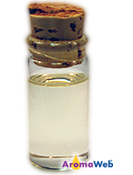Galbanum Essential Oil
Ferula galbaniflua
Galbanum Essential Oil is steam distilled from the resin of a flowering plant that is indigenous to Iran (Persia). Galbanum resin has been widely used as incense and in perfumery since ancient times. It is referenced in the Old Testament:
Then the Lord said to Moses, 'Take fragrant spices - gum resin, onycha and galbanum - and pure frankincense, all in equal amounts, and make a fragrant blend of incense, the work of a perfumer.' - Exodus 30:34-35 (NIV)

Description
Therapeutically, Galbanum Essential Oil is probably most widely known for its anti-inflammatory, anti-microbial and nervine properties. Se the Galbanum Essential Oil Uses section below for more information.
Aromatically, I do not love the aroma of Galbanum Essential Oil on its own. Having said that, I adore blending with it for aromatic and therapeutic applications. When used in moderation, it is a highly versatile oil that blends well with many other essential oils including those within the citrus, wood, resin, earth and herbaceous categories.
Emotionally, I tend to find resinous oils like Galbanum Essential Oil to be calming and to support a peaceful outlook and emotional state.
Spiritually, it's a lovely oil to include in blends intended for meditation and prayer.
Galbanum Essential Oil Benefits and Uses
- Inflammatory Skin Disorders
- Acne
- Pimples
- Cuts
- Wounds
- Scars
- Bronchitis
- Coughs
- Respiratory Issues
- Inflammatory Muscular Aches And Pains
- Rheumatoid Arthritis
- Indigestion
- Nerve-related Conditions
Source: Valerie Ann Worwood, The Complete Book of Essential Oils and Aromatherapy, 25th Anniversary Edition (Novato, CA: New World Library, 2016, 590.
Botanical Name
Plant Family
Common Method of Extraction
Steam Distilled
Plant Part Typically Used
Color
Clear
Consistency
Thin
Perfumery Note
Top
Strength of Initial Aroma
Medium
Aromatic Description
Galbanum Essential Oil smells fresh, green, earthy, balsamic, woody and spicy.
Major Constituents
- B-Pinene
- Gamma-3-Carene
- a-Pinene
- Sabinene
- B-Myrecene
- (+)-Limonene
See Essential Oil Safety for a more complete list of typical constituents.
Source: B.M. Lawrence, Essential Oils 1988-1991 (Wheaton: Allured Publishing, 1993), 82-83. A. Ghannadi, S. Amree, Volatile Oil Constituents of Ferula gummosa Boiss from Kashan, Iran. (Journal of Essential Oil Research 14, 2002), 420-421. Sources cited in Robert Tisserand and Rodney Young, Essential Oil Safety (Second Edition. United Kingdom: Churchill Livingstone Elsevier, 2014), 290.
Galbanum Essential Oil Safety Information
Tisserand and Young do not indicate any special precautions when using Galbanum Oil. However, they precaution to avoid use of the oil if it has oxidized. Reading Tisserand and Young's full profile is recommended. [Robert Tisserand and Rodney Young, Essential Oil Safety (Second Edition. United Kingdom: Churchill Livingstone Elsevier, 2014), 290.]
Galbanum CO2 Supercritical Select Extract
In addition to being available as an essential oil, this botanical is available from a small number of reputable sources as a CO2 extract. CO2 extracts offer many advantages. However, they can have differing safety precautions than essential oils because the natural chemistry of CO2 extracts can differ from their essential oil counterparts. Not much safety information is documented from trusted sources for CO2 extracts. Use CO2 extracts with great care and do not assume that every CO2 extract has the same safety precautions as its essential oil counterpart.
General Safety Information
Do not take any oils internally and do not apply undiluted essential oils, absolutes, CO2s or other concentrated essences onto the skin without advanced essential oil knowledge or consultation from a qualified aromatherapy practitioner. For general dilution information, read AromaWeb's Guide to Diluting Essential Oils. If you are pregnant, epileptic, have liver damage, have cancer, or have any other medical problem, use oils only under the proper guidance of a qualified aromatherapy practitioner. Use extreme caution when using oils with children and be sure to first read the recommended dilution ratios for children. Consult a qualified aromatherapy practitioner before using oils with children, the elderly, if you have medical issues or are taking medications. Before using this or any essential oil, carefully read AromaWeb's Essential Oil Safety Information page. For in-depth information on oil safety issues, read Essential Oil Safety by Robert Tisserand and Rodney Young.
Shelf Life
Important Information About the Profiles
The essential oil information provided on AromaWeb is intended for basic educational purposes only. The references to safety information, test results, constituents and percentages is generalized information. Essential oils can vary greatly in composition. The data is not necessary complete and is not guaranteed to be accurate. The essential oil photos are intended to represent the typical and approximate color of each essential oil. However, essential oil composition and color can vary based on harvesting, distillation, age of the essential oil and other factors. Profiles for several CO2 Extracts and absolutes are included within the directory, and are denoted as such.